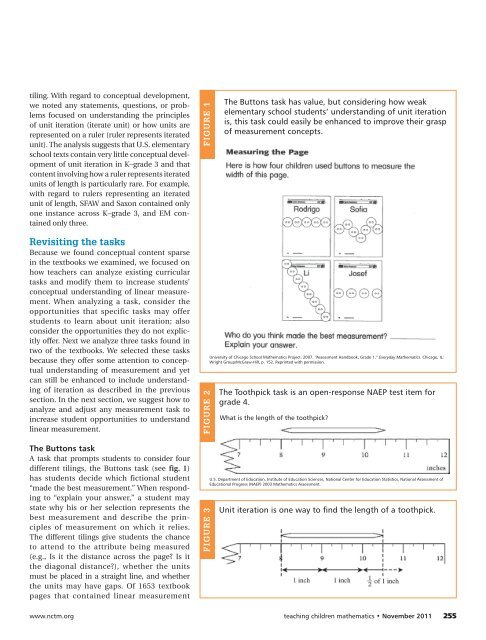Understanding Linear Measurement
Understanding Linear Measurement
Understanding Linear Measurement
You also want an ePaper? Increase the reach of your titles
YUMPU automatically turns print PDFs into web optimized ePapers that Google loves.
tiling. With regard to conceptual development,<br />
we noted any statements, questions, or problems<br />
focused on understanding the principles<br />
of unit iteration (iterate unit) or how units are<br />
represented on a ruler (ruler represents iterated<br />
unit). The analysis suggests that U.S. elementary<br />
school texts contain very little conceptual development<br />
of unit iteration in K–grade 3 and that<br />
content involving how a ruler represents iterated<br />
units of length is particularly rare. For example,<br />
with regard to rulers representing an iterated<br />
unit of length, SFAW and Saxon contained only<br />
one instance across K–grade 3, and EM contained<br />
only three.<br />
Revisiting the tasks<br />
Because we found conceptual content sparse<br />
in the textbooks we examined, we focused on<br />
how teachers can analyze existing curricular<br />
tasks and modify them to increase students’<br />
conceptual understanding of linear measurement.<br />
When analyzing a task, consider the<br />
opportunities that specific tasks may offer<br />
students to learn about unit iteration; also<br />
consider the opportunities they do not explicitly<br />
offer. Next we analyze three tasks found in<br />
two of the textbooks. We selected these tasks<br />
because they offer some attention to conceptual<br />
understanding of measurement and yet<br />
can still be enhanced to include understanding<br />
of iteration as described in the previous<br />
section. In the next section, we suggest how to<br />
analyze and adjust any measurement task to<br />
increase student opportunities to understand<br />
linear measurement.<br />
The Buttons task<br />
A task that prompts students to consider four<br />
different tilings, the Buttons task (see fig. 1)<br />
has students decide which fictional student<br />
“made the best measurement.” When responding<br />
to “explain your answer,” a student may<br />
state why his or her selection represents the<br />
best measurement and describe the principles<br />
of measurement on which it relies.<br />
The different tilings give students the chance<br />
to attend to the attribute being measured<br />
(e.g., Is it the distance across the page? Is it<br />
the diagonal distance?), whether the units<br />
must be placed in a straight line, and whether<br />
the units may have gaps. Of 1653 textbook<br />
pages that contained linear measurement<br />
FiguRe 1<br />
FiguRe 2<br />
FiguRe 3<br />
the Buttons task has value, but considering how weak<br />
elementary school students’ understanding of unit iteration<br />
is, this task could easily be enhanced to improve their grasp<br />
of measurement concepts.<br />
University of chicago School mathematics project. 2007. “Assessment handbook, Grade 1.” Everyday Mathematics. chicago, il:<br />
Wright Group/mcGraw-hill, p. 152. reprinted with permission.<br />
the toothpick task is an open-response NAEp test item for<br />
grade 4.<br />
What is the length of the toothpick?<br />
U.S. Department of Education, institute of Education Sciences, National center for Education Statistics, National Assessment of<br />
Educational progress (NAEp) 2003 mathematics Assessment.<br />
Unit iteration is one way to find the length of a toothpick.<br />
www.nctm.org teaching children mathematics • November 2011 255


